NOTE: This interview with Udana Power was conducted by publicist Bill Murphy in late Spring, 2013. This is Part 3 (covering the years 1976-1979) of what’s likely to be a 4-5 part series of interviews with Udana about her appearances on TV and in movies. We hope you enjoy it!
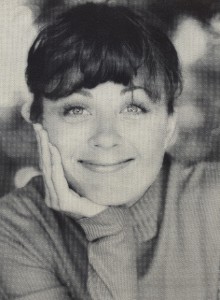 Bill Murphy (BM): Let’s start with Hawaii Five-0, 1976. You did this episode (“Tour De Force, Killer Aboard”) just after LaVerne & Shirley. The show was filmed in Hawaii, so they must have flown you out there, right?
Bill Murphy (BM): Let’s start with Hawaii Five-0, 1976. You did this episode (“Tour De Force, Killer Aboard”) just after LaVerne & Shirley. The show was filmed in Hawaii, so they must have flown you out there, right?
Udana Power (UP): Yes.
BM: What was that experience like?
UP: It was the first time I’d been to Hawaii. It was into the unknown. Exciting. Cliff Gorman [who played the bad guy in the episode] was there. I called him as I got in just to connect with him as an actor. But he didn’t want to. I think he thought I was asking for a date. I wasn’t. The episode was really fun. I didn’t get to see much of Jack Lord. I mean, when you’re working on something like that you’re only there doing your scenes and connecting with the director and the people you’re doing the scenes with as well as the full crew. I remember being in the station wagon [in her first scene]. Remember station wagons?
BM: Oh, yeah. [laughs]
UP: They don’t have station wagons any more. And it was a woody [wood paneled sides] station wagon. The sides were metal, painted to look like wood. (laughter) So 70s and 80s. Here’s another thing I noticed, and I noticed this in the episode of Soap: many women had dark hair, and there were no highlights in the hair. It was pre highlights. [Laughs]
BM: [laughs]
UP: I was killed off in the first few scenes. [Laughs]
BM: Yeah. I think you lasted about 10 minutes into the episode.
UP: Yep. But I threw myself into it like it was a leading role. I was interested in making sure that the scenes were good. I felt like I was up to speed. I knew my lines and, as Spencer Tracy advised a young actor, I knew my lines and didn’t bump into the furniture.
BM: Cliff Gorman. What was he like to work with?
UP: Terrific. He was an excellent actor. Very professional. Intense. I really appreciated his thoughtfulness and his concentration. His spontaneity. That’s what it is about for actors – concentration and responding to each other. I think I had a total of about 3 scenes.
BM: Well, you came out of a hotel building, you got in the station wagon cab.
UP: Yes. And he got in at the same time from the other side, pretending it was an accident. He was setting me up. He said, “Yeah, I’m going to the same place you are. Wow, what a coincidence.” And started flirting.
BM: [laughs] Yeah, and it looks like your character fell in love with him really quickly. You found yourself in that garden and he kept pressing you for information about the hotel.
UP: Yes… I was definitely infatuated. And then I realized that he had an ulterior motive and when I let him know I suspected him, he killed me. So much for romance with a stranger.
BM: [laughs] Well, I think you were in that scene longer than you were in the episode of Kolchak, so that’s something.
UP: That’s true. I was moving up in the world. [laughs]
BM: [laughs] Well the next thing you were in was in ’77. It was Soap. You were in two episodes, both of which you played nurse Nancy Darwin. What was that like?
UP: I loved that. We didn’t realize history was being made, ‘cause we were waiting and hoping that [the show] would get picked up. Nobody knew. The reviews were out. It could have been cancelled by ABC for all we knew. Again, I just showed up and wanted to be as prepared as possible. I thought it through and felt that I was a real nurse writing real things on those clipboards. [laughs]
BM: [laughs]
UP: It was fun flirting [with the character played by Billy Crystal]. One of the things that was extraordinary about that show was the actors they chose. I mean, Richard Mulligan was amazing. Who were the other actors?
BM: Let’s see we’ve got Cathryn Damon and Katherine Helmond.
UP: Yes, yes, the Catherines. They were amazing. All these actors were wonderful. And Diana Canova. They were hilarious. I watched it recently and I was laughing at things that weren’t even funny [laughs] because the actors were so funny. They brought so much to their roles. That is one of the reasons I think that show was so terrific. What they did [in Soap] is they spun it so it was completely outrageous and way far ahead of its time. Harold Gould, what an amazing actor he was. They weren’t looking for pretty people, with lots of surgery, who spent a lot of time in the gym. What they were looking at was really phenomenal characters. In my opinion, that’s what made it work. I loved it.
Bob Urich was so attractive. I didn’t have a scene with Bob, however, I was sitting on the set one day when he walked in. He had so much animal magnetism. I just gasped. I could feel it across the room just pouring off him. [gasp]. It was the first time I had experienced that kind of star quality in a man. He was a hunk. It was tangible. I could then understand why girls screamed and squealed for Elvis and the Beatles. It’s an energy that literally explodes the synapses and giggles you.
BM: [laughs]
UP: He wasn’t just, a handsome guy with a nice face and a good body. He had an energy about him. You put that together with his great looks and, oh my gosh. What fun all that was. I’m glad it got to be so famous.
BM: Tell me a couple of things. Clipboards, you mentioned. When we watch TV, and people – let’s say in an OR, ER, nurses in there – they pick up something, a clipboard, we wonder if there’s anything actually written on it, or if they’re actually writing on it. When you did that scene in the hospital room was there anything actually on that clipboard? Or was it just blank pages?
UP: I put stuff on it, Bill. Absolutely. It wouldn’t be just blank pages. And if it did have blank pages, I had [the prop people] fix it. The clipboard had to have something on it. Because people can tell when you’re pretending. I actually don’t even remember, but I did some research. I was, like. “What would I be writing down?” I had a friend who was a medic, and he said “You’d be writing blood pressure and you’d be testing and looking for this and looking for that.” So I actually went and did a little bit of research and thought about it, because [in a scene] you have to feel like you know what you’re doing. Like you’ve done it over and over and over as a nurse. I remember seeing a movie once before little laptops were popular. In it was a scene that had a little laptop computer on a table. This beautiful, elegant model walked over to the open laptop and then twiddled the keys a little bit. Then she moseyed on about her scene looking gorgeous. Only thing was…she didn’t look like she knew anything about the laptop… or whatever that contraption was. It was obvious that the director said to just go over there and twiddle…pretend that you are writing something. It looked silly and superficial.
BM: [laughs]
UP: That image stuck in my mind. I vowed that I wouldn’t go out and just pretend to be doing something. People read your thoughts and feel your feelings. I’d have to prepare so I could actually live the situation. Experience it. Like I was actually doing it. So that’s what I did in that scene. It’s really fun. Then I get to live a nurse’s life full out and, if I get a number wrong on the chart, it won’t matter. Nobody will die. It’s only television. Ahhhh…I love acting.
BM: How much time is common for somebody like you to put into a role that you know going in is only 10 pages? How much time did you think about the character for each role?
UP: A lot. My habit for doing all of that background and subtext work began when I did a stage play called Jimmy Shine at the Stage Society Theater in West Hollywood. It was on Melrose Avenue. It’s no longer there. I was Constance. Basically, I would literally write down five thoughts for every sentence that Constance said and for anything anybody else in the scene was saying. I wrote down my full subtext. So then I new the full “circuitry” of the person’s thoughts as the play went on, and so when I finally got up in front of an audience I could just go from thought to thought, making decisions as I went along, rather than trying to remember my lines of worrying about what someone else thought of me. Doing that gave me rails to run on. It gives dimension to the lines.
Here’s how I would practice. I would go through the script and get a sense of the scene and how I felt about it. This is fun for me. It’s not work. It is digging to find something wonderful inside the character that drives them. Then I would do lots of subtext writing. And then I got this cassette tape recorder – funny, I doubt if you can even buy a cassette recorder now, they are so passé. Anyway, for each scene I was in I would read everyone else’s lines (in character) into the recorder and leave a blank space for me to say my lines between them. Then, when I was rehearsing, I would just play the tape recorder and practice the scene to the playback. I would be able to memorize the auditory cues as well as the ideas as they were flowing back and forth. Once I got on the set I was ready to exchange energy and thought processes. Exchange the emotional content and ideas. You see, the spoken words are only the scaffolding for what’s really there. All of a sudden you step into a different world. And that’s what it is – its’ about energy. It’s more about exchanging ideas and emotions on a current of energy than it is about anything else.
BM: In the Soap episode, you played the nurse and you had Billy Crystal in there, who is in for a sex-change operation. Harold Gould played an old, dying Jewish guy in the bed beside you.
UP: Yes.
BM: What was it like in a room? There had to be tremendous energy from those actors on that set.
UP: There was. They were brilliant. Yes. It was so much fun. It was like keeping the balls in the air. It was fun. We were all keeping the balls in the air. There was no slack. Everyone was playing full out, the energy was flying, it was wonderful.
That was what’s called a three-camera shoot. We would all sit down at the beginning of the week and do a table read, which means everybody would sit around a table and read their lines from the script they had just received the night before. The writers would listen and take notes and after it was done they would go back to their offices and start re-writes. Meanwhile the actors would immediately get up on their feet and start blocking the scenes. I think Jay Sandrich was the director. He would block the scene with the actors and at the same time start choreographing all the cameras.
At the end of the week an audience would come in. There were huge bleachers set up in the sound stage that would cover the length of all the sets. We had this living room and that living room the hospital room… whatever scenes we were playing that week. Someone like a comedian would come in and warm up the audience before the show… get them laughing and enjoying themselves. And once we were ready to start we would start with the very first scene in the very first set and take the show in order. It was lots of fun. After each scene they wait a moment to make sure the crew had everything before we would move on to the next scene. The warm-up person would entertain the audience who, by that time, would feel like they were as much a part of the show as the actors. If there was any problem with the scene they would go and re-do or correct it before they went on to the next scene. Sometimes something technical would happen, it was rarely with the actors. The actors usually nailed it, but it is a very complicated process behind the scenes. The director is now in a booth with the engineers facing a wall of monitors with feeds from the cameras on the stage. He would be calling the cues, “Camera one, camera three, okay, camera two.” And so on. If they needed a retake the guy who was warming up the audience would jump up and say, “OK everybody, let’s pretend like it’s the firs time and cheer. Cheer, everybody!” And the whole audience would go, “Yaaaay!” It was actually exciting. Fun. I loved that part of it. I’m from the theater. That to me is really, really fun. Again, it’s the energy exchange. That’s the way we did it on Happy Days…well, not the first year. The first year when I was the beatnik was single camera, film. All the rest of them were 3-camera tape. And that’s what it was like on Laverne and Shirley and She’s the Sheriff and Empty Nest.
BM: After Soap, there was a year, and then you went to The Hanna-Barbera Happy Hour.
 UP: Oh yeah! Honey and Sis. I was also shooting lots of commercials. Fifteen to 20 a year. That meant I was on a lot of auditions doling a lot of work and getting some wonderful paychecks. And then Joe Layton, who directed Gone With The Wind at the Music Center, called me in for Honey and Sis.
UP: Oh yeah! Honey and Sis. I was also shooting lots of commercials. Fifteen to 20 a year. That meant I was on a lot of auditions doling a lot of work and getting some wonderful paychecks. And then Joe Layton, who directed Gone With The Wind at the Music Center, called me in for Honey and Sis.
It was so silly. Two puppets. I was the goofy puppet, and there was about two or three puppeteers in black outfits for each puppet. That was when variety shows were still happening. And Jim Henson puppet characters were big. The puppeteers working behind the puppets had sticks that went on the puppets’ hands and moved them around. The show never really took off, but it was a lot of fun to do, and it was fascinating.
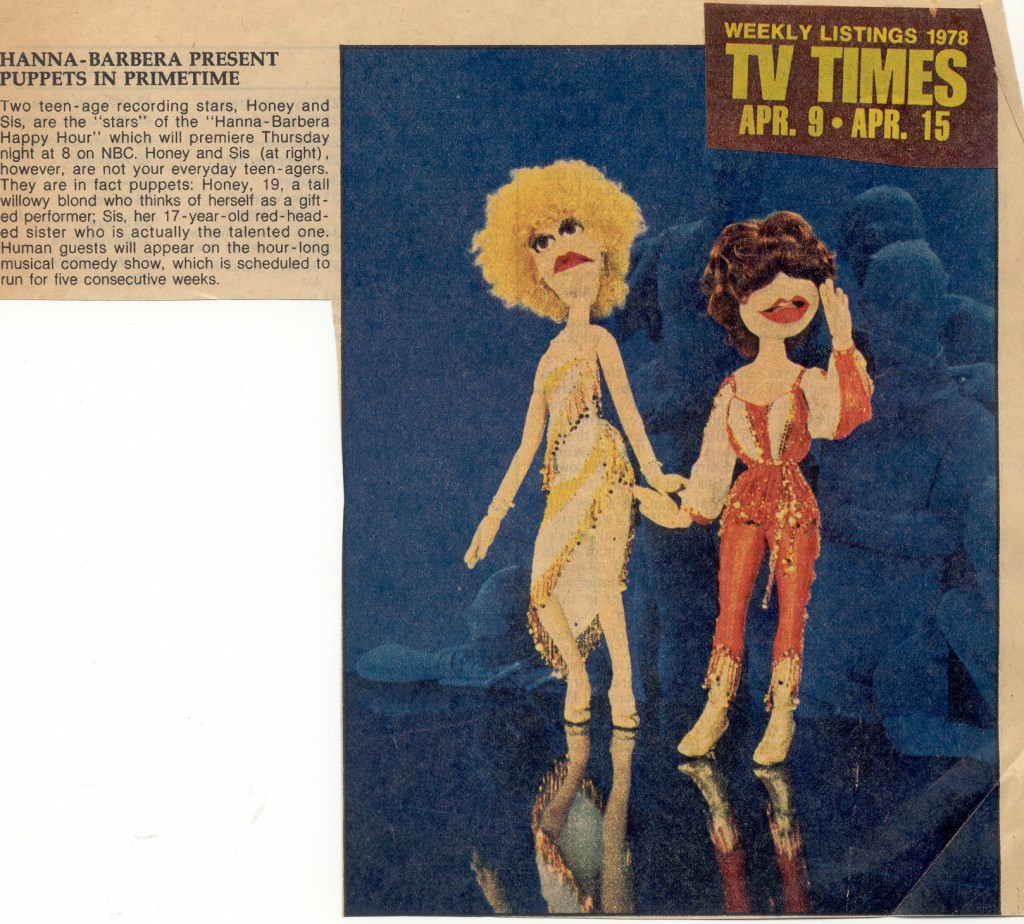 BM: The woman that played Sis, Wendy McKenzie, who was she? According to IMDB, there’s no other listing for her. Who was this person?
BM: The woman that played Sis, Wendy McKenzie, who was she? According to IMDB, there’s no other listing for her. Who was this person?
UP: She was a singer. You know what, that’s interesting. Wendy McKenzie was a fabulous singing teacher. I studied singing with her later. I had studied with a guy named Seth Riggs, who taught all the stars. I knew how the vocal chords worked and had a 3 ½ to 4 octave range with no breaks. Fully blended through the middle. But I had no idea how support worked. Not really. And Wendy said that when she sang she felt like the lower part of her abdomen was working out. It was true support. I thought, “How in the world does that work?” I knew how the vocal chords vibrate together and generate a sound beam that goes up and down in your head like it’s fitting into little slots of a postmaster’s mailbox. But 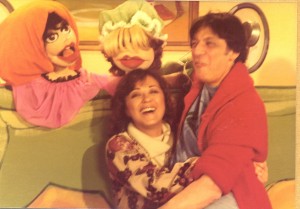 I had not been able to figure out how the support connects to that until I met Wendy. I studied singing with her for a couple of months afterwards to really understand how to engage the whole body. It was fabulous. When I started teaching singing that is what I taught… how to get the vocal chords to approximate properly and after that how to support the sound beam going through the chords and vibrating into the head. I love that part. It’s liberating. Once you get that, you can sing for hours and never get tired. It’s effortless.
I had not been able to figure out how the support connects to that until I met Wendy. I studied singing with her for a couple of months afterwards to really understand how to engage the whole body. It was fabulous. When I started teaching singing that is what I taught… how to get the vocal chords to approximate properly and after that how to support the sound beam going through the chords and vibrating into the head. I love that part. It’s liberating. Once you get that, you can sing for hours and never get tired. It’s effortless.
Anyway…the show never took off. That’s the interesting thing about this industry – nobody actually knows anything. You just do as well as you can and hope that the ingredients all come together and magic happens. But that didn’t happen with Honey and Sis. And it didn’t matter…it was fun. [laughs]
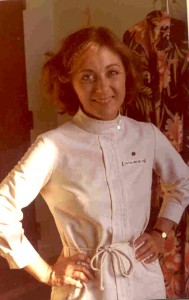 BM: Well, the next thing you were in is a movie, 1978, called The Fifth Floor, where you play a nurse again. What do you remember about that?
BM: Well, the next thing you were in is a movie, 1978, called The Fifth Floor, where you play a nurse again. What do you remember about that?
UP: It was bizarre. It was very low-budget film, and there was a woman producer and her husband directing it [Howard Avedis and Marlene Schmidt]. She set it up so that he would cast people up at his, at their condo north of Malibu, on the beach. And I had to go for an audition up there, and I thought, “This is very strange.” He was kind of an odd kind of guy. I was very, very naïve. So I just was nice, and got the job and showed up and was serious.
BM: So this weird plot line was about a young woman collapses on the disco dance floor, and then she’s committed to an insane asylum. And you must have been the nurse in the asylum.
UP: Yes. Another nurse. And in an insane asylum. Perfect.
BM: We’re talking about a huge cast. It included Bo Hopkins, Patty D’Arbanville, Sharon Farrell, Robert Englund, Julie Adams, Mel Ferrer. I imagine Mel Ferarr probably played a doctor. Yeah, he did, Dr. Sidney Colman. This is a huge cast.
UP: Oh my god. You’re right. You’re absolutely right. Bo Hopkins was huge at that time. Hmmm…how can such a good idea turn out so badly?
BM: Yep. That’s a big cast for a movie that on IMDB is only rated like 4.2. It doesn’t exist anywhere on videotape, DVD, or anything. So it’s apparently not highly regarded.
UP: Yeah, it wasn’t very good. [laughs] But actors just want to work. It’s hard to turn down anything. You never know. I never would have suspected that Happy Days would turn into be something that people would recognize me from for the rest of my life. Who knows? Especially before it happens.
BM: [laughs] Yeah.
UP: And I was another nurse.
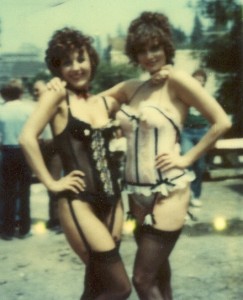 BM: [laughs] Well, the very next thing was much, much more fun for you and much cooler. The was 1979. The movie was Portrait of a Stripper.
BM: [laughs] Well, the very next thing was much, much more fun for you and much cooler. The was 1979. The movie was Portrait of a Stripper.
UP: Oh yeah, that was so much fun.
BM: Tell me, that’s a huge cast, too. And it stars your friend, Lesley Ann Warren. Tell me about that film.
UP: I went on the auditions and they chose me, I knew Lesley was doing it, but we didn’t talk about it before hand. After I was cast, she walked into the office one day and I was there. She was floored. I was set to play her best friend in the movie and we were best friends in real life. It was really fun, we had a ball.
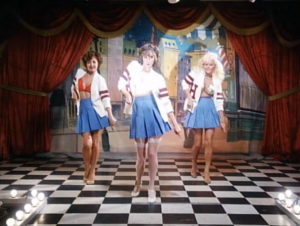 I did a fan dance scene that didn’t end up being in the finished movie. I somehow managed to get the outtakes from the editor. They were on celluloid…now they do everything on tape. They are in my garage somewhere in a large tin box. I hope the celluloid is still okay.
I did a fan dance scene that didn’t end up being in the finished movie. I somehow managed to get the outtakes from the editor. They were on celluloid…now they do everything on tape. They are in my garage somewhere in a large tin box. I hope the celluloid is still okay.
Anyway, Edward Herrmann was fabulous. What an actor. And so was Lesley. She was just fabulous. I watched the movie several times since we’ve been talking about this. And one of the things that shocked me was when we were getting ready we would go into the strip clubs. I’d never been to a strip club. We went into a strip club up on Sunset Boulevard for research. We wanted to know what this world was like for strippers. It was really interesting.
We talked to a couple of the strippers at the club on Sunset Strip. I remember that it was [gasp], you know, kinda scary, actually. That’s one of the things I love about acting. You can throw yourself into things where you know you’re gonna come out alright because it’s only a job, so now you can throw yourself into that world, and you can live it full out as though you’re there, but you absolutely know you’re gonna be OK when you go home that night. You know, you’re not going to be kidnapped or killed or raped or anything like that.
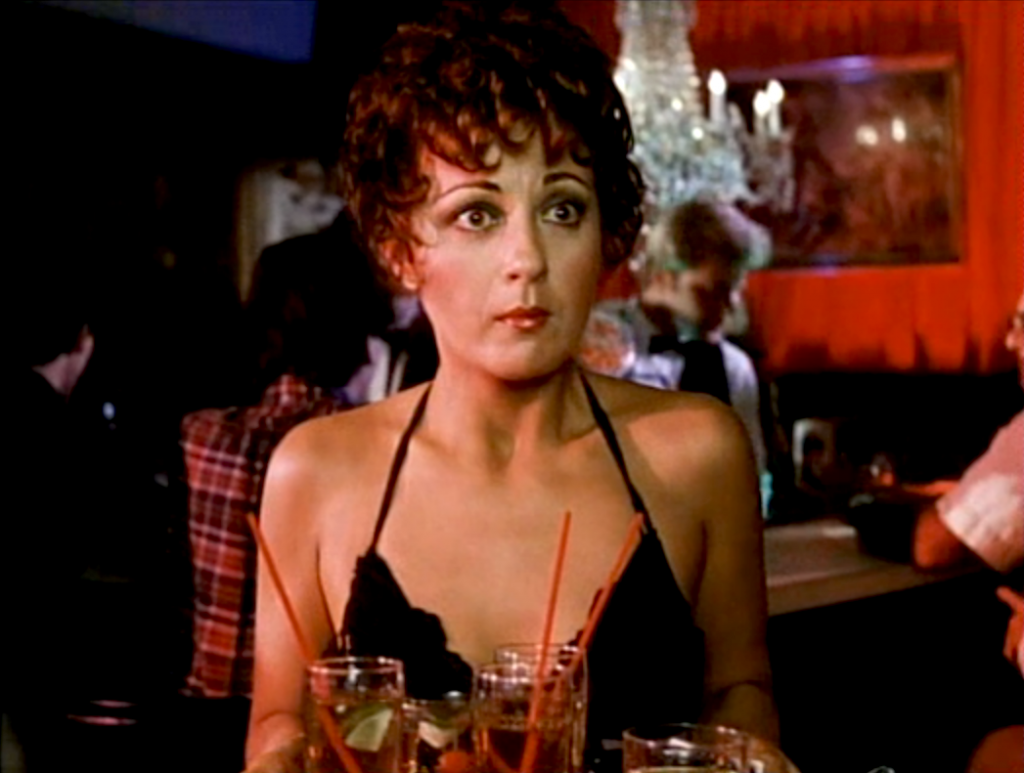 The place where we shot the film was a little club over on Ventura Boulevard. They had body makeup artists. Up until then, It had not occurred to me that when an actress is doing something that shows her body, she gets full body make up. I even found out later that there are major stars who would have body make up artists come over to their house and do their body before they went out on a red carpet. Anyway…I was actually floored. The body makeup artists were true artists. They had many shades of pancake make up so that they could literally shade and sculpt and make the body look ideal. When they got done with me and I finally looked in the mirror, I didn’t even recognize myself. I thought, “Oh my god, that’s not even my body. It’s beautiful.” It was such a relief! I had thought up until then that I had to be perfect all on my own.
The place where we shot the film was a little club over on Ventura Boulevard. They had body makeup artists. Up until then, It had not occurred to me that when an actress is doing something that shows her body, she gets full body make up. I even found out later that there are major stars who would have body make up artists come over to their house and do their body before they went out on a red carpet. Anyway…I was actually floored. The body makeup artists were true artists. They had many shades of pancake make up so that they could literally shade and sculpt and make the body look ideal. When they got done with me and I finally looked in the mirror, I didn’t even recognize myself. I thought, “Oh my god, that’s not even my body. It’s beautiful.” It was such a relief! I had thought up until then that I had to be perfect all on my own.
 BM: [laughs] When you did your research in the strip club, what did you take away from that to put into your role? What did you learn from them where you said, “Ah-ha, now I can play the role this way”?
BM: [laughs] When you did your research in the strip club, what did you take away from that to put into your role? What did you learn from them where you said, “Ah-ha, now I can play the role this way”?
UP: It was fun being that sexy and that erotic. But I was glad I wasn’t living in that world, because it was, at the heart, a tough world.
BM: You had a scene with Sheree North. What do you remember about her? She always played that type of role, like the brothel owner in an Old West movie. Or a night-club singer. What was she really like?
UP: She was fabulous. A real actress. She had a low voice. I guess she was cast because she was the type. She was going along with being typecast. But she was terrific. I thought that the scenes actually went really well. I didn’t sit down and chat with her, get to know her, but we just played the scenes and I just wanted to hit my marks and respond. We were strippers in the club, that’s all. We were all living someone else’s life.
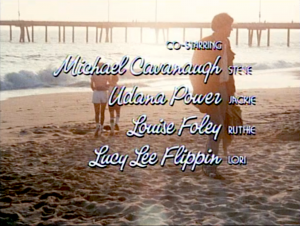 BM: Since you were working with your friend Lesley, did you guys hang out together during the shooting, or in your off hours?
BM: Since you were working with your friend Lesley, did you guys hang out together during the shooting, or in your off hours?
UP: A little bit. We didn’t spend a lot of time offstage, because she was working all the time. I had a good part, but she carried the film. We were focused. I did spend time with Ed Herrmann. I adored Ed.
BM: I always liked him. He’s a great character actor, I always liked his voice, everything about him. I liked seeing him show up in movies and TV shows.
UP: Yeah, he was wonderful. Kind of magical. He was from New York, and we had more time than Leslie did, so we would hang out. He was also a spiritual seeker at the time.
BM: Really?
UP: Yes. He really wanted to know. He gave me some books. I gave him some. I lent him some first editions of Bhagwan [Shree Rajneesh], and he gave them back and he said, “Udana, these are valuable, they’re first editions, and I wanna make sure you have them back.” That was a really significant friendship. He was really a great guy.
BM: So, you’re still close to Lesley?
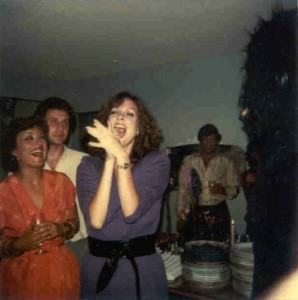 UP: Yes. Lesley and I have been best friends and girlfriends. We take pictures every year in which we would just put our arms around each other. Every year we take the same picture and we put them all together in a line to see the progression.
UP: Yes. Lesley and I have been best friends and girlfriends. We take pictures every year in which we would just put our arms around each other. Every year we take the same picture and we put them all together in a line to see the progression.
BM: Well, cool. Thanks for that. That was perfect. That was a wonderful recap of those shows. It was great.
UP: It was fun. You know what, thank you for having me take a look at them all again. A lot of actors never look at their stuff, ‘cause it’s so difficult. You can’t see yourself clearly. So now we’re, what are we, 40 years later? [laughs] I look at my work and think, “That was really lovely.” You know what it tells me? We should all have great confidence in who we are and what we’re doing all the time. This whole thing about not having any confidence sucks. Feeling embarrassed to love and cherish ourselves is truly idiotic. We must love ourselves and have tremendous self-confidence in our potential so that we can be free to share our uniqueness with the world. I didn’t know it then, but that is my mission – to encourage everyone to be all of who they really are. Full out!
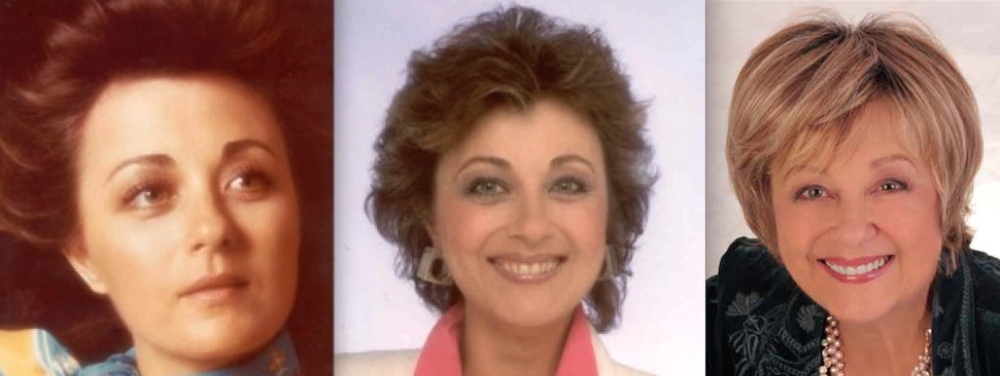
There needs to be video clips from this show online mostly youtube i mean honestly you can find at least 1 clip of any hanna barbera show but this what the heck and as for Honey and Sis when i 1st saw their images when i was 17 a couple years back i instantly fell in love with them this show had a awesome concept why did it not take off
Hi Zachary,
Thank you for your comments! Yes… I agree. We want to get video clips up on line. There are copyright issues with the studios that we have been running into.
Yes… Honey and Sis was fun to do. ! So great to hear someone that enjoyed it.
I will be having someone edit many of the videos I did for SOAP and She’s The Sheriff and other shows… and put some of the scenes that I did online. Hopefully the studios will not force me to take them down.
Thank you for your thoughts! Hope you are having an AMAZING life! It gets better and better as we grow older.
Hi Udana,
I have some questions about the Hawaii Five-O episode you were in. Do you remember when in 1976 was the episode filmed? How many days in total did it take to film all your scenes? About Jack Lord, were you in the scene with him when they wheeled your character into the morgue or was it an extra?